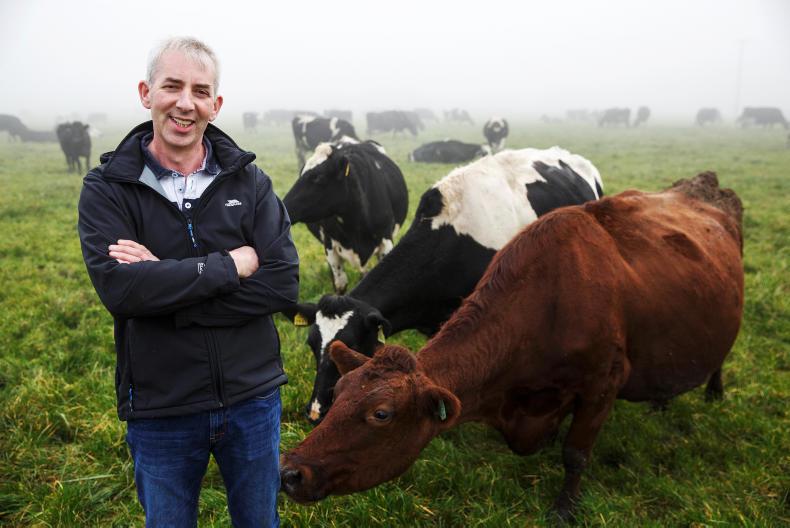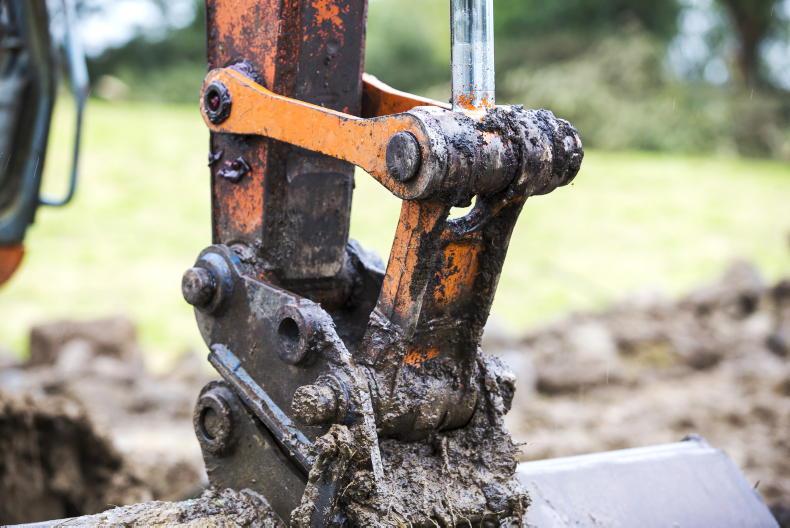The current edition of the Irish Dairy Farmer magazine features the original seven farmers in the Heavy Soils Programme (HSP). Each of these farmers is milking cows on heavy land and in high rainfall areas of the southwest.
Reading their stories, two things immediately stand out – the massive increase in grass growth and milk solids output from the farm since they joined the programme.
One thing feeds into the other, literally. By draining, and improving grassland management, the farmers started to grow more grass. As a result, cow numbers increased which in turn has led to an increase in output. Yes, stocking rate increased, but it did so because the amount of feed being grown on their farms increased so the logical thing to do was to let cows graze it and make more profit.
The catalyst for the extra grass growth, which enabled the increase in output is not just down to one thing. The initial focus of the programme was on drainage but the Teagasc experts will readily agree that this was a mistake. Drainage in isolation will not improve performance, soil fertility must be corrected also.
At a practical level, drainage is the easy part of it – correcting soil fertility is much harder. As Pat Tuohy from Teagasc often says, every field in the world can be drained, it is just a matter of how much money you want to spend on it. Hence there are golf courses built on wetlands all over Ireland.
Phosphorus fixation
The obvious challenges with improving soil fertility are cost and regulation, as farmers are rightly limited in the amount of chemical nitrogen and phosphorus that they can apply to their farms annually, for environmental protection reasons. But the less obvious challenge is that of phosphorus (P) fixation in heavy soils.
This is because on soils with a high clay content (heavy soils), a high proportion of the applied P is fixed to the soil particles and unavailable to the plant, or for soil buildup. This is because of the physical nature of the soil particles and the chemical reaction between it and phosphorus. The level of magnesium and iron in the soil also has an effect. On some heavy clay soils the rate of phosphorus being fixed or locked up can be over 40% higher than on normal soils.
Effectively, these soils are hungry for P so they lock up or fix a large amount of the P that is applied, whether that P is applied in chemical form or in slurry. It’s a bit like filling a sink with water with the sink plug out. You can turn the tap on fully, but if the plug is out, the sink will never fill. It is only when the sink is plugged that it will start to fill up, and the same is true of heavy clay soils. The clay particles are hungry for P and it is not until they are fully satisfied that we will see a lift in soil reserves.
Lifting soil pH is easier on lighter or more organic soils
The problem with P being locked up is made worse when the pH is low, but this is the same for all soil types and is not just a factor for heavy soils. However, lifting soil pH is easier on lighter or more organic soils, eg brown earths as more lime can be applied at a time.
So improving P levels in heavy soils requires three things, firstly the pH must be right (the target is 6.3). Secondly, the P sump or sponge in the clay particles must be full and, lastly, the farmer must have patience because it’s an incredibly slow progress on heavy soils where P levels are depleted.
Another big lesson from drainage on these farms has been the value of the test pit. There are still hundreds of acres being drained in Ireland every year using the one-size-fits-all approach. In many cases, it is the digger driver who is to blame as this is what he was told to do 20 years ago and he hasn’t changed since.
As the farmer who has to a) work the land after the digger leaves and b) write the cheque for the digger hire, it is up to you to install the drainage system that is best suited to your farm. Test pits are necessary. Dig a few in various spots and go down a few metres.
Field drains should be placed where the soil is permeable, ie where to a depth water starts to flow. Decide on the depth of the drain based on this, and hope that the outfall is deeper. If it’s not, it will have to be deepened.

Some of the statistics are staggering. On Sean O’Riordan’s farm in north Cork (pictured), he drained a field using collector drains and sub-soiling. Prior to drainage, the field was only growing 6t/ha in 2012 with a lot of rushes. Sean says it would be late April before he would normally be able to graze the field. The transformation since has been immense. The field grew 12t/ha last year – exactly double what it was growing before drainage.
Take the work done on John Leahy’s farm at Athea, Co Limerick. Before drainage, the field was literally a field of rushes, growing around 1t/ha per year and grazed only once or twice in a year. John says he never spread fertiliser as he felt there was no benefit. This year, four years after being drained, it will grow 8t/ha.
The difference in output between before and after is 7t/ha. If we value this at €160/t, then the length of payback on the investment is 6.4 years. Considering John did a top job on this field, with collector drains and gravel mole ploughs, there is no reason why the drainage system won’t still be functioning in 20 or 30 years’ time.
Mole drains
Further west in Clare, Danny Bermingham is continuing to drain and mould his farm, achieving continual increases in grass growth and milk solids output. His trial field used naked mole drains and Danny reckons it is coming near time that the field will have to be mole-drained again, four years after installation. He thinks this is because the field is beginning to hold water. Mole ploughing again isn’t a big deal – all he needs is the weather, the mole plough and a few hours to do it. Each of the farmers has spent between €2,000 and €3,000 per acre on drainage. Based on the increase in grass growth since, the investment will be paid back within four to eight years. This is a return on capital of between 12.5% and 25%. Where else would you get a pretty much guaranteed return like it? Doubling grass growth on a field is the same as buying or leasing another field. Many farmers are prepared to buy land next door, but only a handful are prepared to double the output on their own farms.
 Outside of features on drainage and soil fertility, the magazine does and in-depth profile on successful dairy farmers across Ireland and the UK. The magazine is available to buy now in newsagents and online here.
Outside of features on drainage and soil fertility, the magazine does and in-depth profile on successful dairy farmers across Ireland and the UK. The magazine is available to buy now in newsagents and online here.
The new edition of the Irish Dairy Farmer magazine is out now.The magazine has a special focus on drainage and soil fertility.Many of the farmers featured have more than doubled grass growth on their drained fields.Some of the other farmers featured include Peter Farrell from Meath, Francis Clune from Clare, Padraig McCarthy from Kerry and James Muir from Staffordshire.
The current edition of the Irish Dairy Farmer magazine features the original seven farmers in the Heavy Soils Programme (HSP). Each of these farmers is milking cows on heavy land and in high rainfall areas of the southwest.
Reading their stories, two things immediately stand out – the massive increase in grass growth and milk solids output from the farm since they joined the programme.
One thing feeds into the other, literally. By draining, and improving grassland management, the farmers started to grow more grass. As a result, cow numbers increased which in turn has led to an increase in output. Yes, stocking rate increased, but it did so because the amount of feed being grown on their farms increased so the logical thing to do was to let cows graze it and make more profit.
The catalyst for the extra grass growth, which enabled the increase in output is not just down to one thing. The initial focus of the programme was on drainage but the Teagasc experts will readily agree that this was a mistake. Drainage in isolation will not improve performance, soil fertility must be corrected also.
At a practical level, drainage is the easy part of it – correcting soil fertility is much harder. As Pat Tuohy from Teagasc often says, every field in the world can be drained, it is just a matter of how much money you want to spend on it. Hence there are golf courses built on wetlands all over Ireland.
Phosphorus fixation
The obvious challenges with improving soil fertility are cost and regulation, as farmers are rightly limited in the amount of chemical nitrogen and phosphorus that they can apply to their farms annually, for environmental protection reasons. But the less obvious challenge is that of phosphorus (P) fixation in heavy soils.
This is because on soils with a high clay content (heavy soils), a high proportion of the applied P is fixed to the soil particles and unavailable to the plant, or for soil buildup. This is because of the physical nature of the soil particles and the chemical reaction between it and phosphorus. The level of magnesium and iron in the soil also has an effect. On some heavy clay soils the rate of phosphorus being fixed or locked up can be over 40% higher than on normal soils.
Effectively, these soils are hungry for P so they lock up or fix a large amount of the P that is applied, whether that P is applied in chemical form or in slurry. It’s a bit like filling a sink with water with the sink plug out. You can turn the tap on fully, but if the plug is out, the sink will never fill. It is only when the sink is plugged that it will start to fill up, and the same is true of heavy clay soils. The clay particles are hungry for P and it is not until they are fully satisfied that we will see a lift in soil reserves.
Lifting soil pH is easier on lighter or more organic soils
The problem with P being locked up is made worse when the pH is low, but this is the same for all soil types and is not just a factor for heavy soils. However, lifting soil pH is easier on lighter or more organic soils, eg brown earths as more lime can be applied at a time.
So improving P levels in heavy soils requires three things, firstly the pH must be right (the target is 6.3). Secondly, the P sump or sponge in the clay particles must be full and, lastly, the farmer must have patience because it’s an incredibly slow progress on heavy soils where P levels are depleted.
Another big lesson from drainage on these farms has been the value of the test pit. There are still hundreds of acres being drained in Ireland every year using the one-size-fits-all approach. In many cases, it is the digger driver who is to blame as this is what he was told to do 20 years ago and he hasn’t changed since.
As the farmer who has to a) work the land after the digger leaves and b) write the cheque for the digger hire, it is up to you to install the drainage system that is best suited to your farm. Test pits are necessary. Dig a few in various spots and go down a few metres.
Field drains should be placed where the soil is permeable, ie where to a depth water starts to flow. Decide on the depth of the drain based on this, and hope that the outfall is deeper. If it’s not, it will have to be deepened.

Some of the statistics are staggering. On Sean O’Riordan’s farm in north Cork (pictured), he drained a field using collector drains and sub-soiling. Prior to drainage, the field was only growing 6t/ha in 2012 with a lot of rushes. Sean says it would be late April before he would normally be able to graze the field. The transformation since has been immense. The field grew 12t/ha last year – exactly double what it was growing before drainage.
Take the work done on John Leahy’s farm at Athea, Co Limerick. Before drainage, the field was literally a field of rushes, growing around 1t/ha per year and grazed only once or twice in a year. John says he never spread fertiliser as he felt there was no benefit. This year, four years after being drained, it will grow 8t/ha.
The difference in output between before and after is 7t/ha. If we value this at €160/t, then the length of payback on the investment is 6.4 years. Considering John did a top job on this field, with collector drains and gravel mole ploughs, there is no reason why the drainage system won’t still be functioning in 20 or 30 years’ time.
Mole drains
Further west in Clare, Danny Bermingham is continuing to drain and mould his farm, achieving continual increases in grass growth and milk solids output. His trial field used naked mole drains and Danny reckons it is coming near time that the field will have to be mole-drained again, four years after installation. He thinks this is because the field is beginning to hold water. Mole ploughing again isn’t a big deal – all he needs is the weather, the mole plough and a few hours to do it. Each of the farmers has spent between €2,000 and €3,000 per acre on drainage. Based on the increase in grass growth since, the investment will be paid back within four to eight years. This is a return on capital of between 12.5% and 25%. Where else would you get a pretty much guaranteed return like it? Doubling grass growth on a field is the same as buying or leasing another field. Many farmers are prepared to buy land next door, but only a handful are prepared to double the output on their own farms.
 Outside of features on drainage and soil fertility, the magazine does and in-depth profile on successful dairy farmers across Ireland and the UK. The magazine is available to buy now in newsagents and online here.
Outside of features on drainage and soil fertility, the magazine does and in-depth profile on successful dairy farmers across Ireland and the UK. The magazine is available to buy now in newsagents and online here.
The new edition of the Irish Dairy Farmer magazine is out now.The magazine has a special focus on drainage and soil fertility.Many of the farmers featured have more than doubled grass growth on their drained fields.Some of the other farmers featured include Peter Farrell from Meath, Francis Clune from Clare, Padraig McCarthy from Kerry and James Muir from Staffordshire. 
 Outside of features on drainage and soil fertility, the magazine does and in-depth profile on successful dairy farmers across Ireland and the UK. The magazine is available to buy now in newsagents and online here.
Outside of features on drainage and soil fertility, the magazine does and in-depth profile on successful dairy farmers across Ireland and the UK. The magazine is available to buy now in newsagents and online here.









SHARING OPTIONS